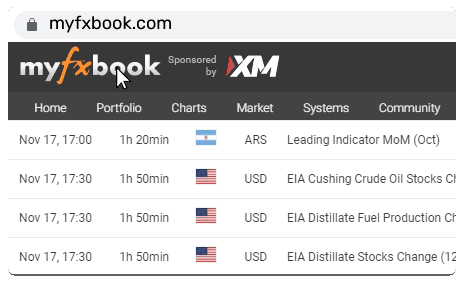How Low Could EUR/USD Go?

In a significant market move, EUR/USD has plunged to levels not seen in over two years, driven by a combination of economic and geopolitical pressures. This sharp decline has been raising questions about the resilience of the eurozone economy and the broader implications for global currency dynamics.
Recent economic data, including eurozone PMIs that fell below expectations, has acted as a catalyst for this downside breakout. Coupled with escalating geopolitical tensions and shifting market sentiment, the euro’s decline has accelerated, leaving traders and policymakers grappling with its implications.
Eurozone PMIs
Source: Finloigx Economic CalendarEconomic Factors Driving the Decline
The euro’s slide can largely be attributed to a weakening eurozone economy, highlighted by disappointing PMI data. These figures have revealed crumbling business confidence across the region, signalling a lack of growth momentum and exacerbating fears of stagnation. With the eurozone struggling to regain its footing, the European Central Bank (ECB) faces mounting pressure to intervene.
EURUSD H1 Chart
Source: Finloigx Charts
The Role of Interest Rate Differentials
Short-term eurozone swap rates dropped by 8-10 basis points following the PMI release, widening the interest rate gap between the euro and the dollar. This rate differential has made the euro less attractive to investors, further intensifying its decline. Market expectations now lean heavily toward a 50-basis-point rate cut by the ECB in December, with projections of a sub-neutral policy rate of 1.75% by mid-2025.
EU02Y Bonds
Source: TradingViewThis anticipated monetary easing highlights the ECB’s role in attempting to counter the eurozone's economic woes. However, such measures also risk devaluing the euro further, particularly against the backdrop of a relatively robust US economy.
Geopolitical Tensions Adding Fuel to the Fire
Beyond economic concerns, geopolitical factors are also weighing heavily on the euro. The ongoing Russia-Ukraine conflict has intensified, raising fears of a prolonged crisis. Although energy prices have remained stable for much of the year, recent upticks in European natural gas prices suggest that energy concerns could resurface as winter approaches.
Additionally, the spectre of global trade tensions looms large. With uncertainties surrounding potential US trade policies and a possible escalation into a broader global trade war, the eurozone’s export-driven economy appears particularly vulnerable. These geopolitical uncertainties compound the challenges facing the euro and contribute to the currency pair's downward trajectory. Click HERE to know know about the geopolitical impacts on the market.
How Low Could EUR/USD Go?
The recent move represents a near 7% decline in EUR/USD over just two months—a pace that is extraordinary by historical standards. While some market participants argue that the euro may be approaching undervalued territory, others believe that further downside is possible, with parity between the euro and the dollar emerging as a realistic scenario.
Technical Analysis
With the 2023 low of 1.0448 already breached, the next significant support zone lies at 1.0190-1.0200. Market sentiment and positioning suggest that the currency pair could test these levels, particularly if economic and geopolitical pressures persist.
Volatility on the Horizon
The EUR/USD pair is also transitioning from a period of historically low volatility to a potentially more turbulent regime. Factors such as uncertainty around global trade policies and escalating geopolitical risks could drive higher volatility in 2025, making the currency pair more unpredictable.
Potential Moderators of the Downtrend
While the outlook for EUR/USD remains bearish, a few factors could slow or temporarily reverse its decline:
ECB Intervention: The speed of the euro’s adjustment may prompt more vocal or direct interventions from ECB officials. Concerns about imported inflation could spur hawkish rhetoric, aiming to stabilize the currency.Seasonal Dollar Weakness: Historically, the dollar tends to weaken in December, which could provide temporary relief for the euro.Energy Prices: If energy prices stabilize or decline, the eurozone’s economic outlook could improve slightly, reducing some of the downward pressure on the euro.Wider Implications for the Eurozone
The current situation underscores deeper structural challenges within the eurozone. From political fragmentation to energy dependency, these vulnerabilities have left the region exposed to both internal and external shocks. Addressing these issues will be crucial for restoring confidence in the euro and ensuring the region's economic stability.
The EUR/USD currency pair is navigating a critical juncture, shaped by a confluence of economic and geopolitical factors. As the eurozone grapples with stagnation and external pressures, the path forward for the euro looks increasingly uncertain. For traders and investors, the current environment calls for heightened vigilance, as market dynamics remain fluid, and risks continue to evolve.
Whether EUR/USD approaches parity or stabilizes at current levels will depend on a range of factors, including ECB policy decisions, geopolitical developments, and broader global market trends. One thing is clear: the coming months are likely to be pivotal for the euro and the broader foreign exchange market.
This content may have been written by a third party. ACY makes no representation or warranty and assumes no liability as to the accuracy or completeness of the information provided, nor any loss arising from any investment based on a recommendation, forecast or other information supplies by any third-party. This content is information only, and does not constitute financial, investment or other advice on which you can rely.



















